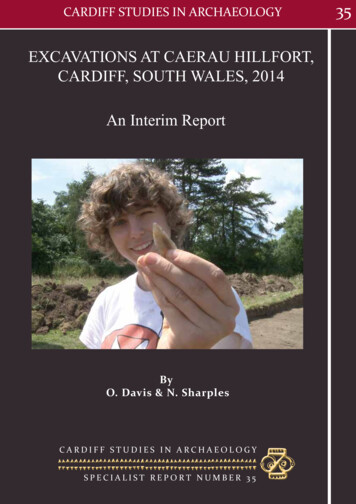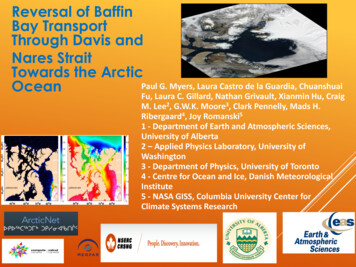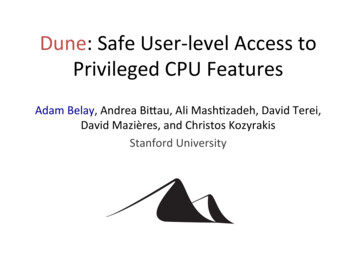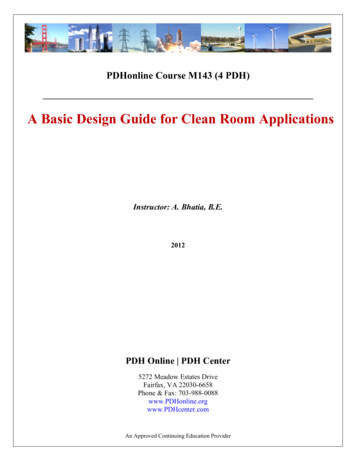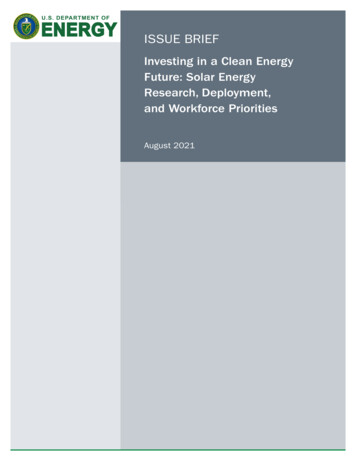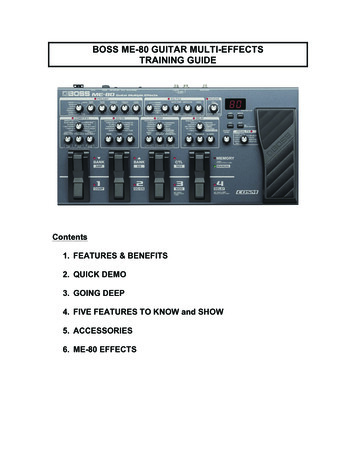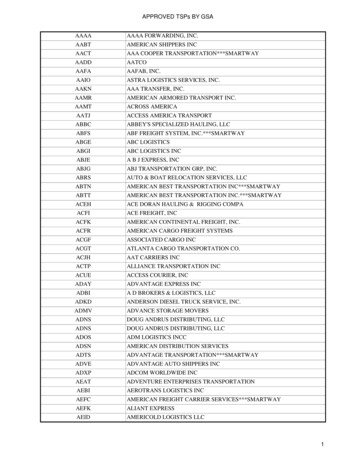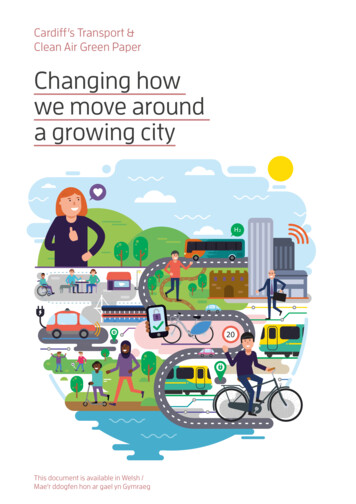
Transcription
Cardiff’s Transport &Clean Air Green PaperChanging howwe move arounda growing cityH²20This document is available in Welsh /Mae’r ddogfen hon ar gael yn Gymraeg
2Cardiff’s Transport & Clean Air Green Paper
ForewordsWe all know Cardiff’s transport network needsto change. Too many of us have been stuck intraffic trying to drop off our children, or late forwork because the bus didn’t turn up, and whilsta growing number want to walk or cycle, thefacilities to do so are often inadequate.But it’s not just about our own inconvenience andfrustration. There is now a more alarming andpressing matter. Pollution levels in Cardiff arenow damaging our health. Improving the air webreathe has become a matter of life or death.It would be simple to just blame everything on cartravel, and say we expect everyone to suddenlybecome a cyclist. But we understand that forsome people car travel is simply essential and wedon’t want to make it more difficult for people togo about their daily lives.Our job is to improve people’s lives, givingpeople the opportunity to choose transportoptions that are healthier, that help us savemoney, that make it safe to enjoy cycling andwalking on a daily basis, and that help us notHow we get from A to B has a huge impact on ourhealth, the environment, and our communities.I have recently explored this more in my AnnualReport, ‘Moving Forwards: healthy travel for all inCardiff and the Vale’. We are at a crucial moment- high levels of illness in our area are caused ormade worse by how we travel and the air webreathe; but there are also once-in-a-generationopportunities open to us to solve this, with thedevelopment of the Metro in Cardiff and thesurrounding region, and legislation requiringand enabling us to prevent future illnesses,improve the health of future generations, andimprove air quality.spend hour after hour satin traffic on the schoolrun or the daily commute.We have an idea of the kindof Cardiff we want. We havebold ambitions for our city. This paper proposesideas of changes we could make that we believewould improve our city. They are all possible. Butwe want to have a conversationwith the people of Cardiff about the issues,and how changes could impact their livesbecause, ultimately, we will all need to shapeour future together.This process will help us decide together thefuture direction of this city, so we can create thechange that improves all our lives and makesCardiff a healthier and stronger city for currentand future generations.Councillor Caro WildCabinet Member forTransport & Strategic PlanningI really welcome thepublication of thisGreen Paper on such animportant subject, andwe are working closelywith Cardiff Council andother partners on theseissues. We urge residentsto engage in this conversation on how we can alltravel in a more healthy and sustainable way. Ifwe get this right we will be healthier and happier,and Cardiff will be one of the best places inEurope to live, work and visit.Dr Sharon HopkinsDirector of Public Health,Cardiff and Vale University Health BoardCardiff’s Transport & Clean Air Green Paper1
How thisdocument worksThe document is made up of six themes, each of whichhas ideas and proposals that we believe could improvetransport and air quality in Cardiff. They are based on goodpractice examples from other progressive cities from acrossthe world, and from ideas taken from a variety of groupsand individuals across Cardiff and beyond.page. 6page. 10page. 14The Future of TheMetro & BusesActive Healthy CityClean Air CityCardiff becomes one of thebest places in Europe foractive travel.All parts of Cardiff will haveclean air. No citizen willhave to suffer ill health as aconsequence of high levelsof pollution.page. 18page. 22page. 26International CapitalCity of Business,Work and CultureThe Future for CarsSmart CityMore Cardiff citizens feel ableto either share or not own acar. Many will choose zerocarbon cars.As the digital world evolves,Cardiff will use the latesttechnology to support anintegrated transport systemin which travellers are wellinformed and able to makesmart travel choices.The Metro forms the heartof a fully integrated publictransport network that ismodern, clean, efficientand affordable.A vibrant ‘destination capitalcity centre’ supporting athriving business economy,major events and a rich,diverse culture.2Cardiff’s Transport & Clean Air Green Paper
How you canget involvedWe want to hear your views and prompt discussions. Eachidea is numbered and you can feed back on some or all ofthem. For each idea we want to get your general views,perhaps let us know how it would impact you personally, orthose in your organisation or community. You can:132Complete ouronline survey at:www.cardiff.gov.uk/transportgreenpaper4Drop off yourcompleted papercopy at any Hubor libraryEmail commentsdirectly to ardiffCouncil7Respond in writingto: Cardiff ResearchCentre, Room401, County Hall,Atlantic Wharf,Cardiff, CF10 4UWOrganise aconsultation eventTake part in afor your group,consultation eventcommunity ororganised by theworkplace and gathercouncil or its partners; people’s views ona list of organisedone or more of theconsultation eventssections.can be found at theweb address above.Cardiff’s Transport & Clean Air Green Paper3
Why does transportmatter to Cardiff?Cardiff is growing faster than any othermajor city in the UK outside of London, andis projected to grow by more than everyother local authority in Wales combined.Over 300m transport trips are made on ournetwork by residents each year, and we allknow that too many of these trips are by car.Driving in Cardiff isn’t much fun – drivers spendan average of four working days a year stuck intraffic during peak periods. 90,000 commutersalso come in and out of Cardiff each day fromoutside of the city.“The latest figures from PublicHealth Wales suggest that thenumber of deaths per year that canbe attributed to poor air quality hasincreased to over 225 across Cardiffand the Vale of Glamorgan.”This traffic is the main contributor to air qualityand congestion generally. It has an effect oneveryone’s quality of life, health and wellbeingin one way or another. The people who suffermost from poor air quality are the very young,the very old and those suffering ill health. Wealso know that poor air quality is worse in themore deprived southern areas of the City, andis caused primarily by cars from outside ofthese communities.4Cardiff’s Transport & Clean Air Green PaperThe population of Cardiff is 360,000 and isprojected to grow by an additional 72,000people over the next 20 years. This growthwill bring about great cultural and economicopportunities, but it will also bring aboutadditional pressures on the quality of our air andthe potential for even more traffic.Cardiff is at an important crossroads. If we wanta fairer, cleaner, healthier and more prosperouscity tomorrow we must make some bravechanges today. If we don’t, then inequality, airquality and congestion will get worse.Cardiff has always risen to the challenge whenit has had to change: from building docks andrailways that helped transport coal from SouthWales to the world, to a city that has managed torefocus its economy after de-industrialisation.Now Cardiff has to change again.This Green Paper will set out what a fairer,cleaner, healthier, prosperous, and moreconvenient city could look like, and gives youa chance to help us decide how we get there.
Cardiff’s Transport & Clean Air Green Paper5
The Future of the Metro and BusesThe Futureof the Metroand BusesH²H²The Metro forms the heart of a fullySmartCityintegrated public transportnetworkthatis modern, clean, efficient and affordable.What’s happening?South Wales MetroThe Welsh Government aresoon to decide which operatorwill take forward the newSouth Wales Metro and widerrail network responsibilities.BusesBus passenger numbers inCardiff are not increasing at therate we would all like. There isconfusion over routes, differentoperators with no transferableticket, and the situation is notOver 750m will be invested in helped by not having a busupgrading the core valley lines, station.adding new modern vehiclesand improving stations.The new Central TransportInterchange will help driveWe believe the new operatora reconfiguration of the buswill bring forward newnetwork, adding more clarity totechnology and begin thestops and routes.implementation of a tramsolution alongside heavy railBus priority schemes have beenlines. We anticipate there willintroduced on key corridorsbe additional stations added to to improve reliability andthe network in Cardiff to meetefficiency of bus journeys andthe demands of a growing city. greater reliability, and morepriority measures are planned.Cardiff Council will work withWe are also developing newthe new Transport for Walesbody and the new operator toensure that a tram system isprioritised with the ability toand extend routes.6 addCardiff’s Transport & Clean Air Green Paperinterchange hubs at the UniversityHospital Wales and Cardiff Westto facilitate interchange betweenservices and modes of travel.We are working with thedevelopers of the strategicsite north of M4 Junction 33 tosecure a new purpose-built Parkand Ride facility as part of thenew housing and commercialdevelopment. We are supportingPark and Ride facilities in otherappropriate locations in Cardiffand neighbouring areas, offeringpeople an attractive alternative tothe car.We are working with NetworkRail and rail operators to identifyopportunities to develop ActiveTravel routes to stations andimproved on-station passengerfacilities.
The big ideas:what morecould be done?The Future of the Metro and BusesH²H²1. Realign the Bus Services NetworkThe introduction of the Metro offers theThe outer routes could, for the time being, runopportunity to comprehensively review theon diesel while smaller electric buses, existingoverall bus network. We could look to realign howtrains and new trams, provide the spokethe network works, creating better connectivityconnections. New rapid bus routes could beSmart Citybetween locations and modes of transport. Forclearly mapped out alongside the new Metro linesexample other cities have switched to routes thatand other transport modes to create a transportrun in circles around the centre with co-ordinated‘masterplan’ for the city.connections inwards like the spokes of a wheel.2. Integrated TicketingA number of cities across the world havedeveloped integrated ticketing systems. If youhave visited London in recent years, you may haveencountered the Oyster Card – a plastic card likea bank card which allows you to hop on and offbuses, trains and tubes as long as you have crediton the card. Transport authorities are increasinglymoving towards a payment system where ticketfares are deducted straight from your bank cardby reading devices on the bus/train/ticket barrier.Proposals for the south Wales Metro includeintegrated ticketing but we could extend thisto include Cardiff buses, and car and bike hirewithin the city.Cardiff’s Transport & Clean Air Green Paper7
3. Zero Carbon Bus FleetWith key bus operation partners, we willinvestigate options for developing a bus fleet thatis powered by electricity or hydrogen and so doesnot contribute to poor air quality. There are manycities around the world and some, like MiltonKeynes, in the UK where electric and hydrogenbuses are already operating. The buses currentlycome with a far higher price tag but we could learnfrom this considerable body of knowledge andmake the right choices for Cardiff.8Cardiff’s Transport & Clean Air Green Paper
What are your views on our 3 bigideas regarding the future of theSouth Wales Metro and buses?On a scale of 1 to 5, (1 being low and 5 beinghigh) how much do you support our big ideas?1. Realign Bus Services with newCity Network and Effective OrbitalBus Hub Network123452. Integrated Ticketing3. Zero Carbon Bus FleetDo you have any other ideas, big or small regarding the futureof the South Wales Metro and buses?What more can you do?Get in touchIf you have never useda bus, try it!cardiff.gov.uk/transportgreenpaperCould you make bus travel aroutine for certain lCardiff’s Transport & Clean Air Green Paper9
ActiveHealthyCityActive Healthy CityCardiff becomes one ofthe best places in EuropeClean Air Cityfor active travel.H²What’s happening?More people are walking towork, to school, to collegeand to the shops.Over a five-year period, therehas been a significant increasein cycling for all journeys.The Nextbike cycle hirescheme will launch in May2018 with 50 Stations and500 bikes.Working with communities,the council has introduced20mph pedestrian-friendlyzones around the city, withmore planned.10 Cardiff’s Transport & Clean Air Green PaperThe numbers of cyclistswithin the city centre hasrisen by around 65%between 2002 and 2016.
The big ideas:what morecould be done?4. Develop Active Travel Zones in thecity centre and in neighbourhoodsAn active travel zone is an area designated as aplace where walking, cycling and non-motorisedtransport take priority. The benefits of suchzones are cleaner air, a healthier lifestyle, safer,quieter streets and more lively, sociable spaces.Children are more likely to play outdoors, cafescan place seating outside, and there is space forplants, trees, lawns and benches. Streets couldbe closed to vehicles at certain times of the day– for example, at the start and close of school orbetween the end of school and 5.30pm to allowchildren to play. Areas in the city centre could bedeveloped as exciting new public spaces, likesquares and green pockets, for all to enjoy.Many cities around the world are creating areaswhere people come first. Sometimes this meansexcluding all types of vehicles, or it can meancombining cycle, bus and tram lanes with muchwider pavements and plazas.The benefits of doing this are many: c leaner air e ncouraging walking/cycling, whichhelps improve physical health m ore social interaction, which helpsreduce loneliness a less stressful environment o pportunities for retailers with greaternumbers of shoppers stopping and browsing o pportunities for open-air seatingand street food stalls o pportunities for cultural and artistic activities,and safer major event management.We would encourage people living in activetravel zones to take up active travel. For example,those who have never cycled before could use anaffordable cycle hire scheme. We would providespecial support to people of limited mobility,helping them use the streets without having torely on a motor vehicle.Cardiff’s Transport & Clean Air Green Paper11
5. Comprehensive CycleSuperhighway & PrimaryCycle Route NetworkOur vision is to develop Cardiff into a cyclingcity where cycling is a normal, practical andsafe choice for short trips for people of allages and abilities. We are already committedto introducing fully segregated CycleSuperhighways in Cardiff. However, we needfurther public support and funding to introducea comprehensive network, including the deliveryof more localised cycling infrastructure, in orderto be faster and bolder in implementing ourcycling strategy6. Total City 20 mph zoneThe vision of Cardiff as a 20mph city is consistentwith encouraging more use of public transport,walking and cycling. Work to increase the numberof 20mph zones is ongoing and we have learnt agreat deal from our pilot areas. We will continueto implement 20mph zones, ensuring that allpeople understand the process, and takingaccount of the fact that designing, consultingand procuring contractors places a significantdemand on resources. However, we could speedup this process if the resources were available tomake larger areas, or the whole city (excludingkey arterial roads) a single 20mph zone.Play Streets - A citywhere children can playfreely and safely outsideof their own homes12 Cardiff’s Transport & Clean Air Green PaperIt is estimated there are now morethan 80 designated ‘play streets’ inEngland and Wales. Dozens of roadsare now being closed to traffic for upto three hours a week as part ofa nationwide drive to bring back‘play streets’.
What are your views on our 3 bigideas for making Cardiff anactive healthy city?On a scale of 1 to 5, (1 being low and 5 beinghigh) how much do you support our big ideas?123454. Develop Active Travel Zones in thecity centre and in neighbourhoods5. Comprehensive Cycle Superhighway & Primary Cycle Route Network6. Total City 20 mph zoneDo you have any other ideas, big or small for helpingCardiff to become a more active healthy city?What more can you do?Get in touchGet that old bike out ofthe garage and mend thatpuncturecardiff.gov.uk/transportgreenpaperIf you have a child you couldtalk with other parents/guardians about a new‘walking bus’ rdiff’s Transport & Clean Air Green Paper 13
Clean Air CityCleanAir CityClean Air CityH²All parts of Cardiff will have clean air. Nocitizen will die or have to suffer ill health asa consequence of high levels of pollution.H²What’s happening?Poor air quality, causedprimarily by traffic congestion,is now recognised across theUK and the rest of the worldas a public health priority. Ithas significant impacts onhealth, child development andenvironmental quality.Clean air is polluted mainly bynitrogen oxides (specificallyNO2) and what is knownas “particulate matter” or“particulates”. In 2012, theInternational Agency forResearch on Cancer listeddiesel exhaust pollution asa Class 1 carcinogen (causescancer). The levels of NO2found in Cardiff are thehighest in Wales, and in someparts of the city exceed EUpollution limits.14 Cardiff’s Transport & Clean Air Green PaperThe Health Crisis in CardiffRecent work by Public HealthWales estimates that theequivalent of over 225 deathseach year – or 5% of alldeaths - can be attributed toparticulate matter and nitrogendioxide (NO2) in the Cardiff andVale Health Board area, withthousandssufferingfromThemoreFutureof Carslong-term illnesses.Cardiff Council has recently beenlegally directed by WelshGovernment to undertake afeasibility study to identify theoption that, in the shortest possibletime, will deliver compliance withlegal limits for air quality.This study, which will report inSeptember 2018, will consider thescale of the current air pollutionchallenge, all of the options andmeasures currently in place orplanned (many of which are set outin this paper) and will recommendwhat will need to happen next toreduce air pollution to legal levels, inthe shortest time possible.Dirty air is now a greater publichealth risk than alcohol orobesity. And the people whosuffer most from poor airquality are the very young, thevery old and those sufferingill health. We also know thatCardiff is not alone in having to tacklepoor air quality is worse inthis issue. Similar feasibility studiesthe moreThedeprivedsouthernFuture of Cars have been recently directed byareas of the City, and is caused government in Bristol, Manchester &primarily by cars from outside Leeds. They have all recommendedof these communities. Thisthat action be taken, including manysituation is untenable andof the big ideas contained within thisrequires urgent action.Green Paper, like improved publictransport in the city and city-region,better cycling and walking routes andhaving more electric vehicles. Theyhave also recommended that thatClean Air Zones should be developed.
Clean Air CityThe big ideas:what morecould be done?H²7. Clean Air ZonesIn cities across the world, Clean Air Zonesare being put in place. The Mayors of Paris,Mexico City, Madrid and Athens have all recentlycommitted to stop the use of all diesel-poweredcars and trucks by the middle of the next decade.Copenhagen’s mayor wants to begin restrictionsas early as next year.In cities like Manchester, Bristol, Leeds andGlasgow plans for Clean Air Zones (or similar) arenow well advanced, and London have alreadyintroduced a Toxicity Charge (T-Charge), withplans for an Ultra Low Emission Zone where allvehicles must meet exhaust emission standardsor pay a daily charge on top of the congestioncharge to be in place by April 2019.What is a Clean Air Zone?A Clean Air Zone is normally an area wheretargeted action is taken to improve air quality,in a way that improves health outcomes andsupports economic growth. There are a numberof different types of clean air zone models inoperation or in development in the UK andEurope that aim to reduce congestion, lowerpollution and raise funds to give people arealistic transport alternative to using their cars.In many Zones access is restricted, or chargesare in place, for vehicles that don’t meet certainemission standards.What area do they typically cover?Some Clean Air Zones cover the whole cityUntil the feasibility work is done, we won’t(Stuttgart, Oxford), while others cover only theknow if a Clean Air Zone is needed in Cardiffmost polluted districts, typically the city centreto reduce air pollution. But we don’t want(London, Milan, Berlin, Glasgow).The Future of Carsgovernment to impose a solution on Cardiff thatdoesn’t work for the people of Cardiff. That’sWhat type of vehicles are typically affected?why we want to start a conversation on thisThere are a number of different models in placeimportant issue now. This is an opportunity foracross Europe and in development in the UK:us to be bold and shape a system that will helpus tackle the challenge of traffic congestion in S ome clean air zones ban the most pollutinga growing city, while also protecting the healthvehicles from entry (Stuttgart, Berlin)and wellbeing of current and future generations. S ome target only the most polluting vehiclesMost importantly of all, we want any system towitha charge (London – T-charge).be fair.Cardiff’s Transport & Clean Air Green Paper 15
Others are adopting a phased approach,where the Zone will charge only buses, HGVsand taxis at first, with additional measures forother vehicles introduced over a period of years(Glasgow, Leeds) Others are in development that will ban allpetrol and diesel vehicles entering the city(Oxford, from 2020).There are often exemptions for newer vehicleswhich meet higher emission standards,emergency services vehicles, electric vehicles,scooters and mopeds.If there was a charge, what would the moneyraised be used for?Any funds raised from Clean Air Zones haveto be ring-fenced for spending on sustainabletransport improvements, like the ones containedin this Green Paper, and could be spent on thingslike:1. L owering bus fares and adding new routes,using clean new electric buses.2. School transport, such as increased school busservices and bus passes for children.3. Improving walking and cycling paths, sopeople have an alternative to paying a charge.8. Active Travel Targets forthe Public Sector and BusinessCardiff’s Public Services Board, which representsthe main public sector organisations responsiblefor Cardiff, has committed to increase activetravel amongst its staff. Plans will be developedin 2018 to support staff in these organisations,and key partners, to take up healthy travel,setting clear, challenging but achievablemonitored targets. Active Travel Plans will also bedeveloped with schools to reduce the numbers ofcars on the “school run.”By working with regional partners and thebusiness community, we could help peoplechoose more sustainable forms of travel;working in partnership to build the infrastructurethat ensures people have safe and attractivealternatives to car travel. This partnershipapproach would show leadership across thepublic and business sectors to meet clean airtargets and improve our city.9. Parking Levies & ChargesIn 2012, Nottingham introduced a workplaceparking levy requiring workplaces to pay foreach parking space provided (charging 387 foreach parking space for businesses with morethan 10 employees)The levy has raised between 8million and 10million a year, which hasbeen used to improve public transport options,including a new tramline.16 Cardiff’s Transport & Clean Air Green PaperCardiff currently has average parking pricescompared to other cities in the UK. Cardiff couldintroduce a workplace levy similar to the onein Nottingham, or seek to increase its generalparking charges. This would dissuade peoplefrom driving into town, while also raising fundsfor public transport alternatives.
What are your views on our3 big ideas for making Cardiffan clean air city?On a scale of 1 to 5, (1 being low and 5 beinghigh) how much do you support our big ideas?123457. Clean Air Zones8. Active Travel Targets for thePublic Sector and Business9. Parking LeviesDo you have any other ideas, big or small for helpingCardiff to improve the quality of its air?What more can you do?Get in touchConsider how you could makechanges to your routine to cutdown on journeys and the useof a carcardiff.gov.uk/transportgreenpaperDiscuss with your workplaceor place of study aboutimproved cycling facilities oraccess to membership of thenew nextbike rdiff’s Transport & Clean Air Green Paper 17
Business,Work andCultureA vibrant ‘destination city centre’ with athriving business economy, supportingmajor events and a Therich,diverseFutureof Cars culture.What’s happening?A city for businessAn accessible cityA destination capital cityCardiff is one of the fastestgrowing and most competitivecities in the UK with aworkforce of over 230,000and 20 million annual visitors.Over the past two years,over 20,000 jobs have beenadded to the city’s economy.Many of these are held bythe 90,000 daily commuterstravelling from outside the city.Businesses are increasinglyseeking locations where theycan access both a sizabletalent pool and consumermarket, and transport also hasa big role in helping to shapehow easy it is to get aroundplaces when you arrive.The car remains the prevailingmeans of getting to work andback. Recent data howevershows that congestion coststhe average driver 1,119 a year.Conversely, active meansof transport are growing inpopularity. Over 45% of cityworkers have at some pointwalked to work, with a similarnumber cycling.Cardiff is the capital city of Wales.It is already a popular destinationfor numerous major internationalsporting and entertainment events.A great place for visitors whoenjoy its shops, cultural eventsand nightlife, and as its reputationcontinues to grow, we want this tobe for the right reasons. We wantthe city centre to be an attractiveexciting ‘destination’.Rail continues to grow inpopularity. Shopping trips by railhave increased by 50% between2007 and 2016. Between 2014and 2016, journeys to work by railincreased by 1.8%.Metro Central18 Cardiff’s Transport & Clean Air Green PaperThe Future of CarsOver half of city centre shoppersover the past year used the city’sbus system – more than anyother form of transport identifiedin the 2017 transport survey.Commuting trends, however,show a downward trajectory forbus use in the city.We are continuing to deliveran outstanding internationalgateway to Cardiff - the newtransport Interchange. This willinclude Cardiff Central rail stationand new links for bus, tram, andbicycle. As well as the focus forbusiness and major events. TheCentral Transport Interchange willbe the core of movement both forthe city and region.
The big ideas:what morecould be done?Smart CityThe Future of Cars10. Creating a high-quality capitalcity centre environmentCardiff City Centre is one of the major assets theregion and nation possesses to attract businessand visitors, as well as a great place for localresidents to live. Creating an internationalhigh-quality, people-focussed, active travel citycentre will underpin major economic benefitsand growth.We want to use the city centre to celebrate thediverse culture and heritage of modern Cardiffand be a showcase for Wales on the internationalstage. In so doing, we will facilitate people tomeet for leisure or business and enable tradersand retailers to create innovative spaces forshopping, eating and entertainment.11. Developing theSouth East CorridorA major opportunity exists to increaseaccessibility for residents and businesses to theeast of Cardiff, one of the city’s most deprivedand disconnected communities. Aligned with thenew Industrial Strategy for the east the city, thiswould include a new park and ride rail stationfor St Mellons, the completion of the EasternBay Link road, further improvement to QueenStreet Station, linked to improved cycling andwalking routes.Cardiff’s Transport & Clean Air Green Paper 19
12. Regional Park & Rides –Improved Regional ConnectionsWorking with regional colleagues and thebusiness community, we could accelerate plansto grow the region’s park and ride network. Newpark and rides would be established to providea more efficient route into the city centre forcommuters. They would be based at junctions33, 34 and north of junction 32 of the M4, and tothe east and west of the city.New York Citypedestrian lanesNew York City authorityrepurposed 26 acres of carlanes as pedestrian zones withsome areas seeing retail activityincreasing by 172%20 Cardiff’s Transport & Clean Air Green Paper
What are your views on our 3 big ideasto help make Cardiff an internationalcapital of business, work and culture?On a scale of 1 to 5, (1 being low and 5 beinghigh) how much do you support our big ideas?1234510. Creating a high-quality capitalcity centre environment11. Developing theSouth East Corridor12. Regional Park & Rides – ImprovedRegional Connections Parking LeviesDo you have any other ideas, big or small to help make Cardiffan international capital of business, work and culture?What more can you do?Get in touchIf you own a business youcould support your staffto make more sustainabletransport choicescardiff.gov.uk/transportgreenpaperTry one of the city’s
the very old and those suffering ill health. We also know that poor air quality is worse in the more deprived southern areas of the City, and is caused primarily by cars from outside of these communities. The population of Cardiff is 360,000 and is projected to grow by an additional 72,000 people over the next 20 years. This growth


